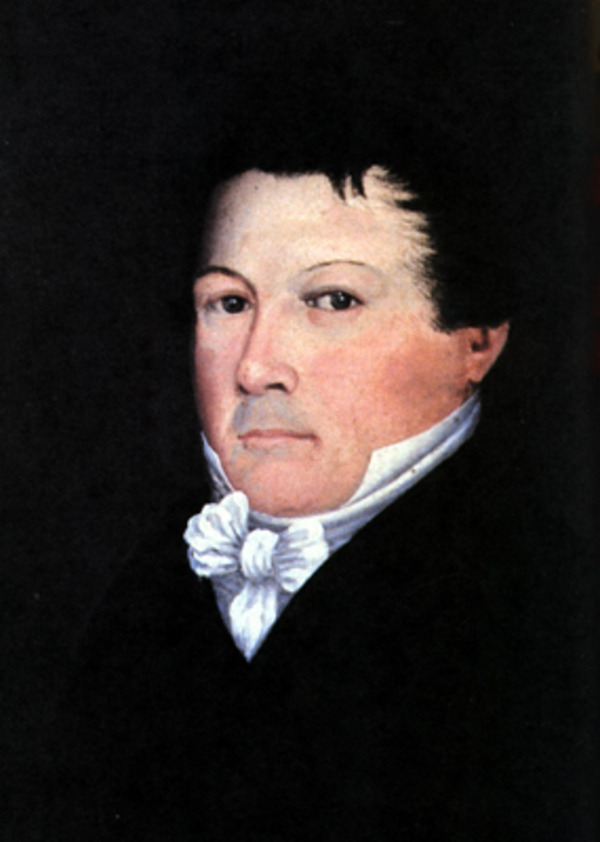
Source: Link
ROY-AUDY, JEAN-BAPTISTE, woodworker and painter; b. 15 Nov. 1778 at Quebec, son of Jean-Baptiste Roy-Audy, a woodworker, and Marguerite Gauvreau; d. probably around the beginning of 1848 in or near Trois-Rivières, Lower Canada.
Jean-Baptiste Roy-Audy was baptized in the cathedral of Notre-Dame at Quebec the day after he was born. Less than a year later his mother died, and he spent his childhood with his father in their house on Rue Saint-Georges (Rue Hébert) and with his uncle Pierre Audy. After some elementary studies he went into his father’s shop, where he did the accounting while learning to work with wood. In the course of his apprenticeship he took drawing lessons from François Baillairgé*. There were ties of friendship linking the two families; in 1811 François and Pierre-Florent* Baillairgé would witness his father’s death certificate.
By 1800 Roy-Audy had become a skilled worker whose reputation extended beyond his Quebec clientele. That year he built an organ case for the fabrique of Notre-Dame in Montreal. In March 1802 he opened a woodworking shop in his father’s house and there he also painted some signs and did some lettering. On 27 July he married Julie Vézina, and they took up residence on Rue Saint-Georges, where they lived until 1808.
Roy-Audy was branching out in his professional occupations. In 1807 he offered his services as woodworker, cabinet-maker, and wheelwright, advising that he could paint, varnish, and add coats of arms to carriages he built. When contracting a promissory note in 1809 he termed himself a painter. Professional artists of the period usually called themselves “historical and portrait painters,” and Roy-Audy can hardly be said to have such a career at this time. But it becomes increasingly evident that he was progressing from simple carpentry to delicate and precise work. By 1818 he had abandoned his labour as a craftsman to launch into an artistic career. There were several factors behind the change: the sale of his assets at auction in 1816 because of financial difficulties, the arrival in 1817 of Philippe-Jean-Louis Desjardins*’s collection of paintings, which would serve as models and as objects for restoration, the beginnings of a market for paintings, and his own artistic talents.
Settling at Saint-Augustin-de-Desmaures, west of Quebec, for the years 1818–24, Roy-Audy finished his training by copying pictures. He did only a few portraits, those of Abbé François-Joseph Deguise (around 1821), Maximilien Globensky* and his wife (1823), and the former governor, the late Sir George Prevost* (1824), amongst them. He concentrated on religious paintings for the churches in Saint-Augustin de-Desmaures, Varennes, Boucherville (1814–24), Longueuil (1820–22), Rivière-du-Loup (Louiseville) (1820), Deschambault (1820–21), Lotbinière (1820–23), and Saint-Roch-de-l’Achigan (1822).
In 1824 Roy-Audy returned to Quebec. Although he advertised in the newspapers, his business was poor. By 1828 he was back in his refuge at Saint-Augustin-de-Desmaures, and then he went to Montreal. In 1831 he did two paintings for the church at Longueuil. It was during this period that Roy-Audy really began producing portraits, with one of himself and another of archpriest R. Fréchette in 1826. In response to market demand he copied those of famous men and did original paintings. His best-known works include portraits of future bishop Rémi Gaulin* (1831), Abbé Jacques-Guillaume Roque (1836?), and future archbishop François-Norbert Blanchet (1838). The last portraits bearing his signature that have been found date from 1838.
Roy-Audy’s subsequent life and career are shrouded in mystery. He seems to have died around the beginning of 1848 leaving no traces. At that time academic art was invading Lower Canada, and self-taught painters such as Roy-Audy had fallen almost wholly out of favour with the public, despite the vigour of their artistic expression.
Jean-Baptiste Roy-Audy’s art was above all naïve, and therein lies its interest. The artist did not master all the techniques of painting, such as perspective, anatomy, foreshortening, and composition. Some of these technical problems obviously diminished when he was doing copies, which constitute the greater part of his religious production. But in portraiture he had to rely solely on his own talent. His instinct as a naïve painter led him to search for the spirit of his subjects and, guided by his elementary sense as a craftsman, he was able, despite his limited technical means, to seize their underlying personality with considerable success.
ANQ-Q, CE1-1, 16 nov. 1778, 15 juill. 1779, 25 juill. 1802, 9 janv. 1811; CN1-16, 21 févr. 1809; CN1-253, 1er août 1824. AP, Notre-Dame de Montréal, boîte 1800, 1.5–6; Saint-Antoine (Longueuil), livres de comptes, 2: f.57. Arch. du monastère des ursulines (Québec), Fonds L.-J. Desjardins. MAC-CD, Fonds Morisset, 2, dossiers François Baillairgé, J.-B. Roy-Audy. Quebec Gazette, 25 March 1802; 14 May, 4 June 1807; 25 April 1816. Michel Cauchon, Jean-Baptiste Roy-Audy, 1778–c.1848 (Québec, 1971).
Cite This Article
Michel Cauchon, “ROY-AUDY, JEAN-BAPTISTE,” in Dictionary of Canadian Biography, vol. 7, University of Toronto/Université Laval, 2003–, accessed January 20, 2025, https://www.biographi.ca/en/bio/roy_audy_jean_baptiste_7E.html.
The citation above shows the format for footnotes and endnotes according to the Chicago manual of style (16th edition). Information to be used in other citation formats:
| Permalink: | https://www.biographi.ca/en/bio/roy_audy_jean_baptiste_7E.html |
| Author of Article: | Michel Cauchon |
| Title of Article: | ROY-AUDY, JEAN-BAPTISTE |
| Publication Name: | Dictionary of Canadian Biography, vol. 7 |
| Publisher: | University of Toronto/Université Laval |
| Year of revision: | 1988 |
| Access Date: | January 20, 2025 |



